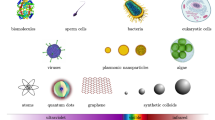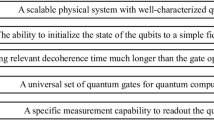Abstract
Over 40 years ago, Hartman noted that the tunneling time τ of a particle through a barrier becomes independent of width for thick barriers. Lately, the Hartman effect has been seen as a support for superluminal tunneling time. By interpreting the reflection and transmission amplitudes in terms of multiple reflection series, we show that τ is linear in barrier width for thin barriers and may be associated with actual traversal time; for thick barriers, τ saturates to the Hartman value because of the suppression of all but the first term of the series due to the smallness of the tunneling factor. For large widths, τ cannot be identified with the propagation time but may be associated with a time to penetrate to a characteristic depth into the barrier, which is independent of width. We discuss data from frustrated internal reflection experiments, which support this view.
Similar content being viewed by others
References
L. A. MacColl, Phys. Rev. 40, 621 (1932).
T. E. Hartman, J. Appl. Phys. 33, 3427 (1962).
R. Landauer and Th. Martin, Rev. Mod. Phys. 66, 217 (1994); E. H. Hauge and J. A. Stövneng, Rev. Mod. Phys. 61, 917 (1989).
G. Nimtz, Prog. Quantum Electron. 27, 417 (2003).
V. Delgado and J. A. Muga, Phys. Rev. A 56, 3425 (1997); M. Buttiker, in Time in Quantum Mechanics, Ed. by G. Muga, R. Sala Mayato, and I. L. Egusquiza (Springer, Berlin, 2002).
V. S. Olkhovsky, E. Recami, and J. Jakiel, Phys. Rep. 398, 133 (2004); D. Sokolowski and Liu, Phys. Rev. A 63, 012 109 (2000); M. Buttiker, Phys. Rev. B 27, 6178 (1983).
S. Longhi et al., Phys. Rev. E 64, 055 602 (2001); Ch. Spielmann et al., Phys. Rev. Lett. 73, 2308 (1994).
Ph. Balcou and L. Dutriaux, Phys. Rev. Lett. 78, 851 (1997).
A. Dogariu, A. Kuzmich, and L. H. Wang, Phys. Rev. A 63, 053806 (2001); G. Nimtz and W. Heitmann, Prog. Quantum Electron. 21, 81 (1997).
H. Winful, Phys. Rev. Lett. 91, 260401 (2003); 90, 023901 (2003).
B. H. Bransden and J. C. Joachain, Introduction to Quantum Mechanics (Longman Scientifical and Technical, London, 1989), p. 152.
J. C. Martinez and E. Polatdemir, Phys. Scr. 68, 108 (2003); F. T. Smith, Phys. Rev. 118, 349 (1960).
Th. Martin and R. Laundauer, Phys. Rev. A 45, 2611 (1992); A. M. Steinberg and R. Chiao, Phys. Rev. A 49, 3289 (1994).
P. Meystre and M. Sargent III, Elements of Quantum Optics (Springer, Heidelberg, 1990); A. Siegman, Lasers (Oxford Univ. Press, Oxford, 1986).
B. R. Horowitz and T. Tamir, J. Opt. Soc. Am. 61, 586 (1971).
M. Born and E. Wolf, Principles of Optics (Cambridge Univ. Press, Cambridge, 1999).
A. K. Ghatak et al., Opt. Commun. 56, 313 (1986).
N. K. V. Lotsch, Optik (Stuttgart) 26, 112, 181, 299, 553 (1970).
A. Haibel, G. Nimitz, and A. Stahlhofen, Phys. Rev. E 63, 047601 (2001).
Author information
Authors and Affiliations
Additional information
Original Text © Astro, Ltd., 2006.
Rights and permissions
About this article
Cite this article
Martinez, J.C. Confronting the Hartman effect with data from frustrated total internal reflection (FTIR). Laser Phys. 16, 1123–1127 (2006). https://doi.org/10.1134/S1054660X06070176
Received:
Issue Date:
DOI: https://doi.org/10.1134/S1054660X06070176




